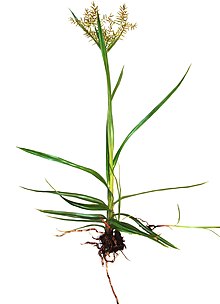| Chufa sedge | |
|---|---|

| |
| Scientific classification | |
| Kingdom: | Plantae |
| Clade: | Tracheophytes |
| Clade: | Angiosperms |
| Clade: | Monocots |
| Clade: | Commelinids |
| Order: | Poales |
| Family: | Cyperaceae |
| Genus: | Cyperus |
| Species: | C. esculentus
|
| Binomial name | |
| Cyperus esculentus | |
| Synonyms[2] | |
|
Synonymy
| |
Cyperus esculentus (also called chufa,[3] tiger nut,[4] atadwe,[5] yellow nutsedge,[6] earth almond, and in Chishona, pfende[7]) is a species of plant in the sedge family widespread across much of the world.[8] It is found in most of the Eastern Hemisphere, including Southern Europe, Africa and Madagascar, as well as the Middle East and the Indian subcontinent.[9][10][11] C. esculentus is cultivated for its edible tubers, called earth almonds or tiger nuts (due to the stripes on their tubers and their hard shell), as a snack food and for the preparation of horchata de chufa, a sweet, milk-like beverage.[12][13]
Cyperus esculentus can be found wild, as a weed, or as a crop. It is an invasive species outside its native range, and is readily transported accidentally to become invasive. In many countries, C. esculentus is considered a weed.[12][14] It is often found in wet soils such as rice paddies and peanut farms as well as well-irrigated lawns and golf courses during warm weather.
- ^ Kumar, B. (2013). "Cyperus esculentus". IUCN Red List of Threatened Species. 2013: e.T164083A17636573. doi:10.2305/IUCN.UK.2013-1.RLTS.T164083A17636573.en. Retrieved 25 November 2022.
- ^ "Cyperus esculentus L. — The Plant List". www.theplantlist.org. Archived from the original on 2020-06-01. Retrieved 2014-02-08.
- ^ "Chufa Information". Seed World. Retrieved 2020-04-29.
- ^ Chen, Angus (April 27, 2016). "Loathed By Farmers, Loved By Ancients: The Strange History of Tiger Nuts". NPR. Retrieved January 5, 2021.
- ^ "Is Atadwe (Tiger Nuts) Good for You? Health Benefits of Tiger Nuts". GhanaStar. 2015-11-15. Retrieved 2020-04-29.
- ^ "Yellow nutsedge". University of Maryland Extension. Retrieved January 5, 2021.[permanent dead link]
- ^ "Chufa (Earth Almond)". Chest of Books. Retrieved January 5, 2021.
- ^ Sánchez‐Zapata, Elena; Fernández‐López, Juana; Pérez‐Alvarez, José Angel (2012-07-01). "Tiger Nut (Cyperus esculentus) Commercialization: Health Aspects, Composition, Properties, and Food Applications". Comprehensive Reviews in Food Science and Food Safety. 11 (4): 366–377. doi:10.1111/j.1541-4337.2012.00190.x. ISSN 1541-4337.
- ^ "World Checklist of Selected Plant Families: Royal Botanic Gardens, Kew". Kew Science. Archived from the original on April 5, 2011. Retrieved January 5, 2021.
- ^ "Biota of North America Program, 2013 county distribution map". Archived from the original on 2014-08-08. Retrieved 2014-07-24.
- ^ Altervista Flora Italiana, Zigolo dolce, Yellow Nutsedge, Cyperus esculentus L. Archived 2014-07-21 at the Wayback Machine includes photographs plus distribution maps for Europe and North America
- ^ a b "Cyperus esculentus (yellow nutsedge)". CABI. 19 November 2018. Archived from the original on 2 May 2019. Retrieved 31 October 2019.
- ^ Nazish, Noma. "What Are Tiger Nuts And Why Should You Eat Them?". Forbes. Retrieved 2022-01-17.
- ^ Sánchez-Zapata, E; Fernández-López, J; Angel Pérez-Alvarez, J (2012). "Tiger Nut (Cyperus esculentus) Commercialization: Health Aspects, Composition, Properties, and Food Applications". Comprehensive Reviews in Food Science and Food Safety. 11 (4): 366–77. doi:10.1111/j.1541-4337.2012.00190.x.
